Applying the Bondarchuk Method of Training: Martin Bingisser
Leave a CommentSystematic Planning for Your Athletes
Developing a plan for your athletes can be problematic, time consuming and potentially useless. Martin Bingisser gave some very useful tips in his GAIN presentation which will help coaches looking to develop a system.
Martin is an advocate of the Bondarchuk system of training which uses a limited sequence of exercises over a period of a few weeks before switching to another sequence and repeating. His thoughts on planning around this system were enlightening, even though I don’t use the Bondarchuk system.
Martin said that the much touted Soviet Training methods focussed on the plan, the processes and then the system. He said this was back to front.
The system you use should be the foundation of what you do, then the processes that help you implement the system, and then the plan of what you do.
This is similar to Simon Sinek’s “Start with why” and used by Jim Radcliffe of University of Oregon.
4 steps of the Planning Process
Martin takes a 4-step approach to planning.
- Define
- Plan
- Experiment
- Change
1 Define: Know your sport, your position and your athlete before you start.
You need some general guidelines before you start planning. For example the more specific the exercises, the greater their transfer to the sport will be. The more experienced the athlete is, the fewer useful tools you will be able to use.
You need to define which tools will be suitable for which athlete and position. You need to define exercise selection. He favours a lot more General Physical Education exercises rather than Specific Development Exercises.
(I took the time to do this a few years ago when I created my coaching toolbox on Excel. I was finding I was only using exercises that were most recent in my memory, rather than using what had worked 10 years previously. Taking time out to do this saves a lot of time in the future).
2 Plan: Putting the pieces together.
“All training causes physiological adaptations.” So everything works at the beginning or to some extent. Knowing what works for your athletes at what stage of their career is important.
Plan for transfer, but also plan for balance.
(I use this with the cyclists I coach: they spend so much time in a flexed and compressed position, that I put extension and inversion into every training session. This has no impact on their cycling performance, but it does allow their body to become balanced which then allows them to spend more time on their bike.)
3 Experiment: Go out and train.
All training is an experiment, so try it and learn from the feedback. (It has to be said that Martin is currently an active competitor in the Hammer, but I agree that every coach can try things out to some extent).
Experiment also applies to adapting and improving your coaching cues. “Make your feedback useful and frictionless”.
Martin has also learnt by experimentation what matters in training and what measures are useful. By limiting the variables in training (fewer exercises, more consistent stimulus and don’t overreach) it is easier to get consistency in training.
The nature of the Bondarchuk method is that the athlete is peaking 6 times a year and with more peaks you get more feedback. This means that you can learn lessons every 2 months and change, rather than wait for 6 months and realise you are on the right track.
(I haven’t used the Bondarchuk method, but there is a lot to be said about focussing on one thing at a time and improving that, measuring it and adapting. Compared to “Workout of the Day” madness where you are constantly changing focus).
4 Change: It’s the driver of adaptation.
“Change when you’re on top, rather than at the bottom” said Martin. This means continuous reflection and adaptation.
You can make short term changes with a long term change in mind. For example, if the long term goal is to improve throwing ability, then changing the leg strength exercises from back squat to front squat after 2 months may force a further adaptation.
“If it is the same programme every year, how can you cause an adaptation?”
Martin listed details of the exercises within his programme, as well as showing video clips of how they transferred to his sport of Hammer throwing.
Whether you use the Bondarchuk method or not, the thinking behind his seminar was sound and can be applied elsewhere.
Coaches wishing to learn more about Athletic Development can book onto one of our coaching courses.


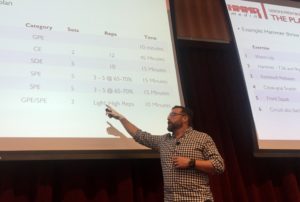
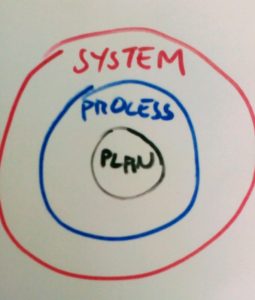


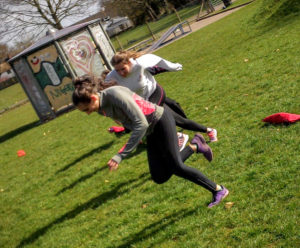

 Gary gave some insights into how he does plan his training. He said that volume in speed/ power programmes has little variation.
Gary gave some insights into how he does plan his training. He said that volume in speed/ power programmes has little variation.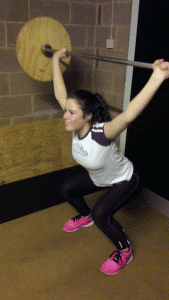
 Interestingly, many of these studies showed that both groups increased strength in equal amounts up until the periodisation group began a phase of lower volume.
Interestingly, many of these studies showed that both groups increased strength in equal amounts up until the periodisation group began a phase of lower volume.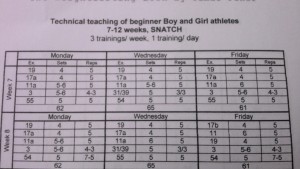
 “The interaction and interdependence of the training components” is what planning training is about.
“The interaction and interdependence of the training components” is what planning training is about. “Every time you train you put money in the bank, every time you compete you take money out“.
“Every time you train you put money in the bank, every time you compete you take money out“. After all the planning takes place, it is easy to think that the athlete’s day revolves around the 2 hours that we spend with them.
After all the planning takes place, it is easy to think that the athlete’s day revolves around the 2 hours that we spend with them.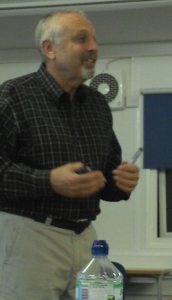 Vern took some questions and then presented on his coaching journey and some lessons he has learnt. To me this is the crucial part that is missing in education in this country.
Vern took some questions and then presented on his coaching journey and some lessons he has learnt. To me this is the crucial part that is missing in education in this country.
 As Andrew Hamilton remarked a couple of weeks ago on the blog festival with regards to sports nutrition: Walk before you run. It constantly amazes me how clueless young athletes are about simpel eating facts. One of the reasons is that society has beome distant from food in its natural state. Do youngsters go scrumping anymore? (that would combine the tree climbing for pulling strength and healthy eating!).
As Andrew Hamilton remarked a couple of weeks ago on the blog festival with regards to sports nutrition: Walk before you run. It constantly amazes me how clueless young athletes are about simpel eating facts. One of the reasons is that society has beome distant from food in its natural state. Do youngsters go scrumping anymore? (that would combine the tree climbing for pulling strength and healthy eating!).